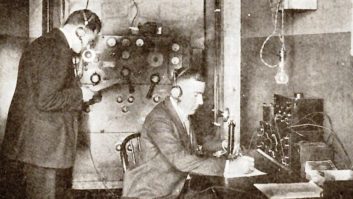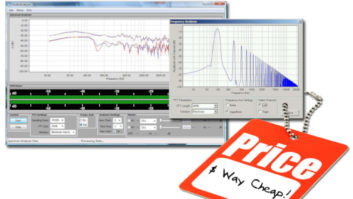(click thumbnail)The Petzl Motto: ‘To Each His Headlamp.’ The Zipka model is worn like a sun visor.Robert Gonsett’s CGC Communicator recently spoke of white-colored light-emitting diodes (LEDs) being incorporated into long-lasting flashlight products.
One offering from Petzl (motto: “To Each His Headlamp”) has a variety of applications. The Zipka Headlamp is worn like a sun visor, and the high-intensity lamp can be adjusted to keep your hands free to do the work.
Find out more at www.petzl.com/FRENG/frheadlamps/headlampframe.html.

. . .
At lat fall’s NAB Radio Show, many useful tips were provided by manufacturers during the AM/FM Transmitter Workshop.
For example, owners of Nautel Ampfet 1 through 10 transmitters should invest in a bottle of Caig Labs’ Deoxit to clean the prongs of the Cinch-Jones plugs used on this transmitter’s modules. A film can develop, causing intermittent module operation.
Also on this transmitter, it’s a good idea to check the security of mounting hardware in the RF filter annually, particularly mechanical connections between the capacitors, inductors and associated leads. As you inspect the hardware and connections, be alert for discoloration, which signifies overheating.
Nautel engineers discovered an interesting phenomenon involving module aluminum air filters. As flies and other insects were caught on the outside screen of the air filter, their acidic body juices would eat away at the aluminum. Nautel engineers have replaced the aluminum filters with a two-piece plastic air filter.
Protective circuitry is only good when it works. Owners of the ND-10 transmitter should check the VSWR protection on an annual basis. During a maintenance session, the procedure is to reverse the FWD/REF power leads, located at the output filter. Then slowly bring up the power.
The VSWR protection circuitry should trip when the threshold is exceeded.
. . .
Owners of the Harris MS-15 and MX-15 exciters would be wise to have on hand not only a spare exciter fan, but also U-1 (for the MS-15) and Q-1 (for the MX-15). Should the fan fail on this exciter, many times this regulator is taken out, too.
If you have a Harris FM3.5K and HT-3.5, 5, 7 or 10 FM transmitter, check the tightness of hardware throughout the transmitter, but especially in the RF cabinet, every year. PA Screen or Plate overloads in this transmitter usually can be traced to a bad PA tube, a dirty arc gap in the PA or a power-supply component failure.
The FM-25K RF splitter and combiner are made up of a number of coaxial cables. As the transmitter ages, these cables can dry out and become brittle.
This effect can change the impedance of the cable to something other than 50 ohms. The same problem can occur on the IPA, so check these cables when you start seeing interstage reflected power or tuning instability.
Harris engineers replaced the older stainless steel arc gap with a carbon arc gap, which is easier to maintain.
When seating tubes in these transmitters, the tube is seated properly when the screen ring is covered by the contact assembly. If you monitor filament voltage to extend tube life, Harris recommends lowering the voltage until the power just starts to drop. At that point, raise the filament voltage to 10 percent above that drop-off level.
Did you know that even three missing fingerstock on a tube socket can affect the transmitter’s efficiency? Check your tube socket not only for cleanliness but also for missing fingerstock when you change your tube.
. . .
Martin Cooper is president of Transcom Corp., a transmitter reseller. Martin has good tips for keeping the resale value of your transmitter. Keep the rig clean. Avoid home-brew modifications. When you must create one, document it on the schematic.
If you’re looking for a home for a transmitter built prior to 1975, keep in mind that there is no real fair market value. Transmitters built prior to 1978 must have PCB filled capacitors removed. Martin warned that selling a transmitter laden with PCB capacitors to someone does not obviate your responsibility as the “original owner” of the PCB-filled caps.
Martin suggested contacting your local power utility company for removal and disposal. Their rates are much more reasonable than the environmental companies that provided this service when the EPA’s ruling first came out.
One of the biggest life-shortening threats is heat. Martin cautioned to get the heat out of the transmitter. You can dump the heat from tube transmitters into the adjacent building, but make sure a fan or blower ensures a constant flow of air to prevent back pressure from developing and reducing your cooling.
Submissions for this column are encouraged, and qualify for SBE recertification credit. Fax your submission to (703) 323-8044, or send e-mail to [email protected].












